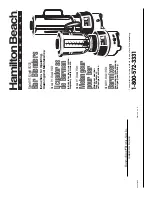
18
6.9.3
Interpretation – compare the status shown to the
following terminals and the wiring diagram. For
example, starter 1M “on” signal at J4 4 and 8 is dis-
play No. 3 and should be a “1” if the 1M starter is
energized.
Input
J4
Input No.
Signal
Terminals
On Display
Local **
1 to 2
1
Remote
3 to 2
2
1M
4 to 5
3
2M
6 to 5
4
3M
7 to 8
5
*
DP1
9 to 8
6
*
DP2
10 to 11
7
*
DP3
12 to 11
8
*
Low Level
18 to 17
12
*
7 Day Timer
19 to 20
13
*
Optional
** This input is also used for remote start when the selector switch
is in the REMOTE position.
NOTE: Terminal No.’s on the right, e.g., 2, 5, 8, etc. are all in common.
6.9.4
Corrective Action – compare the inputs on to the
device/s connected to the digital inputs and trigger
same. If a “1” is not received check the associated
wiring or the particular device and correct or replace
the cause of the fault.
6.9.5
Controller Operation – the keyboard (except the
CLEAR key) and all LED’s cannot change state. The
display is dedicated to the digital input display. The
program is otherwise active.
6.9.6
Exit – press CLEAR twice and then press ENTER
twice.
6.10
READ ONLY ANALOG INPUTS
6.10.1
To enter (from normal scroll) – press CLEAR key
twice and press SERVICE TEST key once. Then
press CLEAR key once.
6.10.2
Display – ANALOG INPUT TEST on top line and input
type and measurement on bottom line. Press key 1,
2, 3 or 4 to read channels 1, 2, 3 or 4 in % with 4mA
@ 20% and 20mA at 100%. Six other items may be
accessed with the up arrow key. These items are:
RTD 1(˚F), RTD 2(˚F), Dc supply (DCV), and power
board readings. “Power Board Readings” is now dis-
played on top line. These readings are: voltage in
volts, current in amps, and power in watts.
6.10.3
Interruption – read channel values from connected
devices with channel 1 as suction pressure, channel
2 as system pressure, channel 3 as flow input
(optional) and channel 4 is unused at this time.
If there is a problem replace the analog source with a
known source such as a 20mA signal generator.
Connections to terminal block J3 are as follows:
Source
2 Wire
*Step
Signal
Input
Terms
Terms
1
Suction
1
1-, 2+
2-, 3+
2
System
2
5-, 6+
6-, 3+
3
Flow
3
7-, 8+
8-, 9+
Polarity shown is that of the signal analyzer
and not the markings on the I/O board.
4
not used
4
—
—
5
RTD1
RTD in 1
—
13, 14
6
RTD2
RTD in 2
—
16, 17
A substitute 100 OHM resistor @ terms.
13 & 14, or 16 & 17 will result in a temperature
reading of 32˚F.
7
DC Supply = 24.00 VDC ± 10% satisfactory.
8
Display top line changes to: Power Board
Readings.
8
Voltage = XXX VAC equal to system line
voltage.
9
Current = XXX amps equal to actual load.
10
Power = XXX watts actual power.
* Step = each momentary step of up arrow key.
6.10.4
Corrective Action – correct the wiring or a faulty
device. If a signal is good with a signal generator then
the inter-connection wires are good and the sensor is
bad. In the case of RTD’s a substitute 100 OHM
resistor will isolate a problem to the sensor.
Power board readings may be confirmed by a sepa-
rate clamp-on line current readings, line voltage read-
ing, and calculations for watts.
6.10.5
Controller Operation – keyboard (except arrows,
clear, 1, 2, 3, 4) and all LED’s cannot change state.
The display is dedicated to the analog input display.
The program is otherwise active.
6.10.6
Exit – press CLEAR once and then press ENTER
twice.
6.11
MANUAL CONTROL – OUTPUTS
To enter this section a user code (serial no.) is
required. Since the program is being overridden cau-
tion must be exercised.
IF NOT SURE CALL THE FACTORY. IF “USER
CODE” IS DISPLAYED PRESS THE ENTER KEY
TWICE TO RETURN TO NORMAL SCROLL.
DO NOT LEAVE UNIT IN SERVICE TEST.
6.12
DIGITAL OUTPUTS
6.12.1
To enter:
A. Normal scroll on display
B. Press CLEAR twice
C. Press SERVICE TEST
D. Press CLEAR twice
E. Enter user code (serial no.)
F. Press ENTER key
WARNING: Prevent electrical shocks. Disconnect
the power supply before beginning installation.
Failure to follow these instructions could result in
serious personal injury, death, and/or property damage.
DANGER: Troubleshooting live control panels ex-
poses personnel to hazardous voltages. Electrical
troubleshooting must only be done by a qualified electri-
cian. Failure to follow these instructions could result
in serious personal injury, death, and/or property
damage.











































